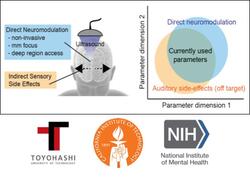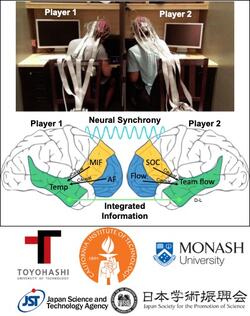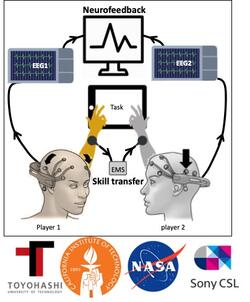
Mohammad Shehata
| Affiliation | Institute for Research on Next-generation Semiconductor and Sensing Science (IRES²) |
|---|---|
| Title | Associate Professor |
| Fields of Research | Neuroscience |
| Degree | Ph.D. (Neuroscience; University of Toyama) |
| Academic Societies | The Japan Neuroscience Society; Society for Neuroscience |
| shehata@vpac.cs Please append ".tut.ac.jp" to the end of the address above. |
|
| Laboratory website URL | http://www.vpac.cs.tut.ac.jp/ |
| Researcher information URL(researchmap) | Researcher information |
Theme1:Elucidating the neurocognitive mechanism of Team Flow
Overview
The flow state, or getting into the zone, is a known phenomenon in positive psychology that develops when there is a balance between the skills of the individual and the challenge of the task given clear goals and immediate feedback. “Team flow” occurs when a group falls into the flow while sharing a common goal towards task completion as in sports teams, music ensembles, dance squads, or teams in video gameplay. Although individual flow is known to have a positive effect on several life experiences, team flow shows enhanced positive effects, including enhanced creativity, productivity, and emotions.
As team dynamics depends on coordinated actions, it requires coordinated brains. Hyper-scanning, recording brain activities of the interacting individuals simultaneously, studies revealed consistent findings of inter-brains synchronization or brain-to-brain coupling in social tasks such as interbody synchronization, speech coordination, music production and dancers, student-teacher interactions, and enhanced creativity in cooperative social task.
We recently established a team flow experimental setup in the lab while hyper-scanning using electroencephalograms (EEG)(Figure, upper panel). We have developed a methodology to distinguish the flow brain state from the non-flow state based on auditory-evoked potential (AEP) as a measure of the intense selective attention to the task. Also, we have isolated neural markers of “team flow” including higher inter-brain synchrony and a unique brain integrated information network (Figure, lower panel) as compared to “team, no flow” and “no team, flow” experiences.
Selected publications and works
1- Shehata, M., Cheng, M., Tseng, C., Nakauchi, S., Shimojo, S. (2018) Neural correlates of interpersonal flow experience. Organization of Human Brain Mapping Annual Meeting (Singapore).
2- Shehata, M., Elnagar, S., Yasunaga, S., Nakauchi, S., Shimojo, S. (2018). Flow of the eye: Gaze direction as an objective measure of flow experience, VSS2018 (St. Pete Beach, USA).
3- Shehata M., C. M., Wu D., Tseng C., Nakauchi S., Shimojo S. in Society for Neuroscience Meeting Planner. Program No. 249.15. (Chicago, IL, 2019).
4- Shehata M., C. M., Leung A., Tsuchiya N., Wu D., Tseng C., Nakauchi S., Shimojo S. in Neural Imaging Reveals Neural Correlates of Human Social Behavior press conference at the Society for Neuroscience Annual Meeting "Neuroscience 2019".
Keywords
Theme2:Wearable “Team Flow” real-time monitoring and modulation system
Overview
Working in a space environment with extended duration of isolation, confinement, and extreme conditions can lead to a decline in the cognitive and behavioral functions. Consecutively, this decline might affect the crews' mental health, where they may develop depression, for instance, leading to poor teamwork behavior with a negative impact on the crews' performance and mission success. NASA's Human Research Program (HRP) identified these risks at the element "Human Factors and Behavioral Performance (HFBP)" under two categories short-titled "Team" and "BMed." This project directly addresses these risks by providing an objective method for assessing the optimal performance with euphoric social empathy of teams during space missions.
The rapid spread of the COVID-19 infectious disease led to many governments' recommendations to flatten the curve of spreading through several measures. One measure is to decrease direct person-to-person interactions by issuing stay-at-home orders. These orders extended, so far, for several months and might be extended further. People being isolated in their homes might result in increased levels of depression and stress and generally negatively affect mental health. This isolation state is similar to working in a space environment with an extended duration of isolation and can lead to a decline in the cognitive and behavioral functions. Therefore, the public might benefit from the same methods developed at/under development in our ongoing project with NASA. Hence, we plan to extend our application beyond space health to public health. This plan will require developing an online data collection methodology, including psychometric and EEG data. The extension of our strategy to the public will help enhance general mental health and performance during home isolation in the COVID-19 instance or any future incidence.
Keywords
Theme3:Ultrasonic neuromodulation
Overview
 Optimizing the ultrasound parameters to maximize the direct neuromodulation effects and minimize the auditory (sensory) side effects.
Optimizing the ultrasound parameters to maximize the direct neuromodulation effects and minimize the auditory (sensory) side effects.Low intensity ultrasonic neuromodulation (UNM) has the potential to serve as a unique tool for neuroscience research based on ultrasound's ability to be focused non-invasively in deep brain regions and modulate neural activity, and shown in several studies in model organisms and humans. However, recent findings in rodents have show that, in addition to any direct modulation of the brain, UNM can indirectly elicit the activation of auditory and/or the somatosensory cortical circuits, which pose a potential confound for the reliable use of this technology in human neuroscience.
The purpose of this project is to characterize both the direct and the indirect sensory effects of UNM in humans to assess the ability of this technology to serve as a reliable tool for neuroscience research and for treatment of psychiatric diseases.



